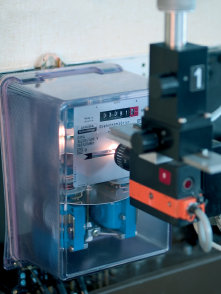Electrical Energy and Power
Realisation of the units of electrical energy and power
The BEV standard for electrical energy and power is a power comparator which is calibrated regularly at the Physikalisch-Technische Bundesanstalt (PTB), Germany. This comparator provides the calibration of the working standards of our own laboratory as well as of the standards of calibration and verification laboratories.
The measuring principle is based on a long-term stable analogue-thermal procedure. The measurement of the alternating quantities, current and voltage and their resulting power, is traceable to a direct voltage measurement which serves as a base quantity. Besides the measurement of current, power U and active power P, a digital measuring device can calculate other electrical quantities of relevance to the power industry, such as: reactive power Q, apparent power S and power factor cos j.
Verification of Electricity Meters and Tariff meters

The Measuring Instruments Directive (MID) has been applied in all EU Member States since October 30, 2006 regulating the first placing on the market of measuring instruments subject to mandatory verification.
These measuring instruments have to undergo a conformity assessment procedure.
Active electrical energy meters are included in the MID. Meters that exclusively measure active electrical energy can be placed on the market without national type approval or initial verification. Conformity assessment is equivalent to initial verification.
Modules B+D, B+F or H1 are the conformity assessment procedures applicable to electricity meters.
See also Measuring Instruments Directive MI-003.
Electricity meters with additional functions not mentioned in this Directive are subject to national regulations as prior to MID. Examples in the field of electricity are the following functions: reactive energy, measurement of reactive and active power, load profile and all other quantities not regulated in the MID.
Consequently, combined electricity meters require a conformity assessment procedure for functions mentioned in the MID, and a national type approval and initial verification for additional functions. This national initial verification is carried out by accredited verification bodies in Austria or by verification bodies in other countries authorized and supervised by the BEV.
The new and subsequent verification of electricity meters and tariff meters is always subject to national regulations and is carried out by accredited verification bodies in Austria or by verification bodies in other countries authorized and supervised by the BEV.
The reverification period of electricity meters is between 4 and 20 years, depending on the category. A prolongation of the reverification period by 5 years is possible on the basis of a statistical examination.
Electrical tariff meters can also calculate additional quantities from the power measured by the electricity meters, such as power mean value over a measuring period of 15 minutes or a load profile (memory of power behaviour over hours).
As soon as electrical quantities generated in this way are used in official and public transactions, these electrical tariff meters are also subject to mandatory verification.